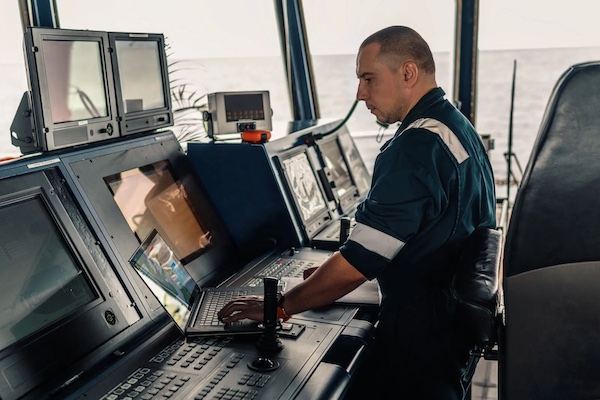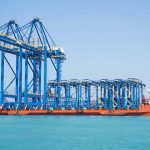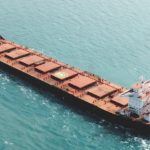Accelerating digital development and evolving expectations are driving rapidly rising demand for maritime connectivity, presenting both challenges and opportunities for the global shipping industry.
The shipping industry needs to take a strategic approach to connectivity in order to meet its evolving business needs. This was the ethos of a thought-provoking interactive seminar on the state of play in the maritime connectivity market hosted by Inmarsat and moderated by Joshua Flood, Co-Founder & Senior Research Consultant at Valour Consultancy. The Future of Maritime Connectivity session explored the reasons for, and ramifications of, soaring connectivity demands in the sector.
Invited to provide their unique perspectives on the topic were Dr Phanthian Zuesongdham, Head of Division Port Process Solution and Lead Coordinator smartPORT, Digital Maritime and ITS, Hamburg Port Authority; Florian Liebetrau, Director IT – Marine and Maritime Operations, Hapag-Lloyd; and Marco Cristoforo Camporeale, Senior Director, Growth Markets, Inmarsat Maritime.
In his introduction to the seminar, Flood described the period since the onset of the Covid-19 pandemic as, “the perfect storm of conditions that would have caused adversity to many other industries but created a real boom in the maritime connectivity market”. With crew stranded at sea requiring connectivity to communicate with family and friends and to access entertainment, telemedicine and training services, the pandemic “propelled digital strategies forward by about five years”, he explained.
Emphasising Flood’s point while offering the shipowner’s outlook, Hapag-Lloyd’s Florian Liebetrau commented: “We generate a lot more data today than we did a few years ago, and we do a lot more with that data. Satellite communications were previously a peripheral element of our fleet operations but are now becoming a central component – in terms of both crew welfare and data collection and transfer.”
This trend is reflected throughout the industry, with Inmarsat’s Marco Cristoforo Camporeale revealing that maritime data consumption has risen almost threefold since before the pandemic and by 70% in the past year alone. However, as the industry’s reliance on connectivity grows, so does the threat to cyber security: in the last 12 months, cyber-attacks have increased by 80%, added Camporeale.
According to Dr Phanthian Zuesongdham of the Hamburg Port Authority, the issue of cyber security concerns not only onboard IT, but also OT – or operational technology. “The equipment and components aboard modern vessels are more intelligent than ever, collecting large volumes of data and producing numerous insights,” she said. “This leaves ships more exposed to cyber-attacks, so there is a clear need for cyber-security strategies to apply to OT as well as to IT.”
While the advancement of maritime connectivity creates more vulnerabilities to digital threats, a robust network connection also provides a platform for effective cyber-security measures and solutions, explained Camporeale. “Through our reliable, industry-leading VSAT services, we deliver a solution that goes beyond compliance to consider every aspect of cyber security,” he said. “First, we segregate IT, OT and crew networks; then, we deploy unified threat management to monitor and combat all threats on a single device; and finally, we provide crew cyber-security training to further minimise risk.”
Another challenge associated with the growing demand for maritime connectivity is the cost and complexity of contracting more than one service provider for vessels that operate in various locations. “One of the main concerns that we have is the integration of systems,” said Liebetrau. “Having a ship operating around the world with multiple IP addresses and different connectivity backbones is expensive and complicated. Ideally, we would have one integrated product that allows the vessel to switch automatically to whichever technology is needed depending on where it is sailing.”
Camporeale acknowledged the need for an enhanced network as the solution.
“Connectivity already brings a competitive advantage in areas such as crew recruitment and fuel efficiency,” said Camporeale. “In a survey commissioned by Inmarsat, one in three seafarers identified onboard internet as the most important factor in deciding which company to work for, while digital technology has been shown to cut fuel consumption by up to 18% by leveraging the insights shipping companies collect from vessel and machinery data.”
“Shipping will need to connect and exchange more in the years ahead,” he continued. “The networks are becoming more sophisticated to meet this demand, while connectivity is the lifeblood of digitalisation in the maritime industry. Many technologies, such as voyage and port call optimisation, automation, condition–based maintenance, and other, are required to work together to deliver impacts that affect change in shipping. But when orchestrated and combined within an interconnected system, digital technologies can give rise to significant gains in efficiency, customer value, and profitability.”
Source: Hellenic Shipping News






